By Mican Allen Andrews, ASID, NCIDQ | Design Director
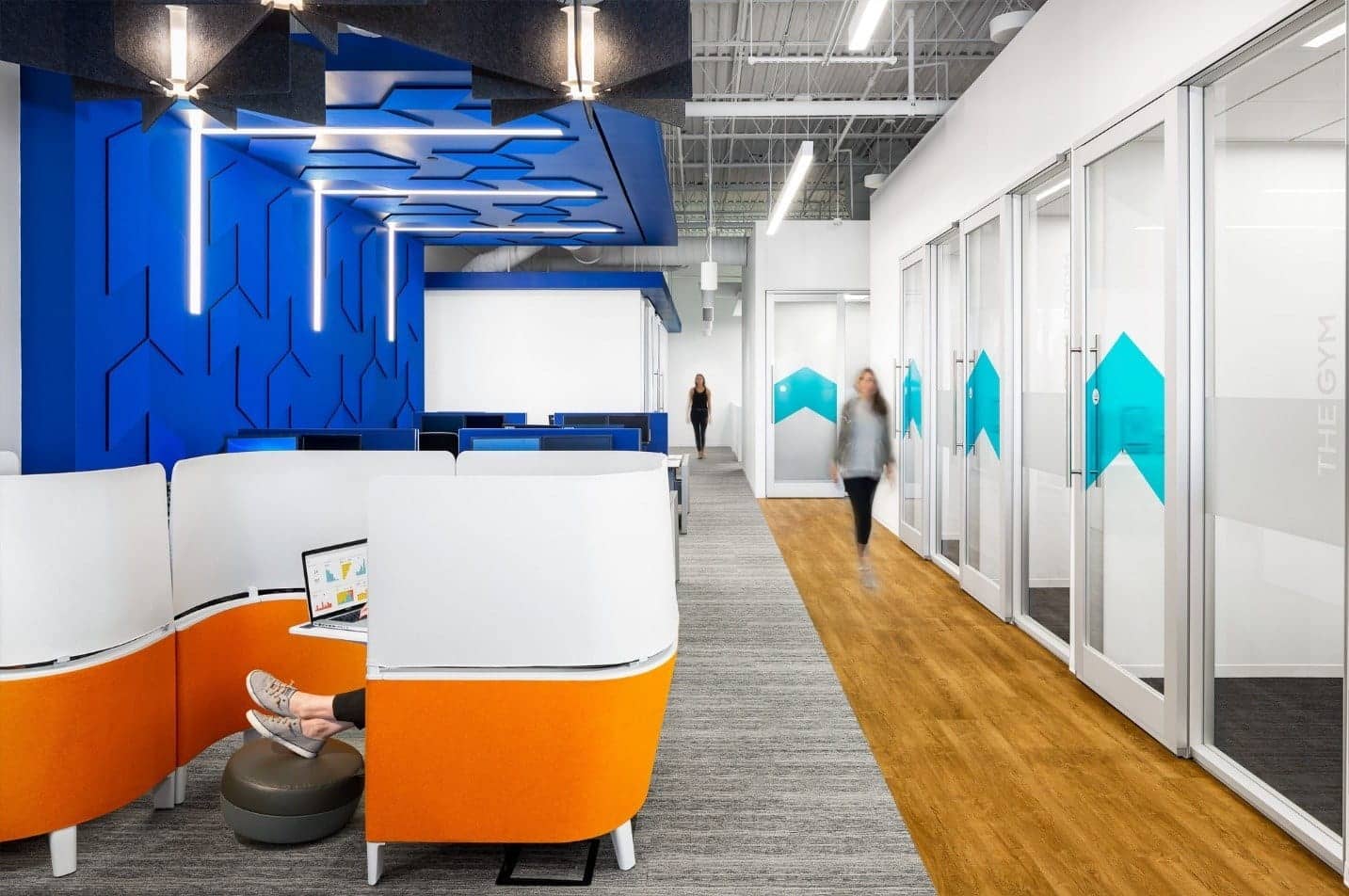
Unassigned seating options can offer employees appealing alternatives to flexible work arrangements. Confidential Client, Kennesaw, GA. Photography © Katie Bricker.
As the trend of corporate workplace design has shifted toward an open concept, workplaces have struggled to find the appropriate level of ancillary space to balance so much public work space. As designers, we’ve been tasked with providing creative solutions to find the perfect balance utilizing an array of:
- free-address or unassigned work arrangements
- hoteling stations within the open office
- work lounges or break areas that can also double as informal collaboration hubs or secondary workplaces
- soft seating clusters within the open office or in conference areas
- dedicated phone rooms and associated work surfaces
Simultaneously, however, there is a growing desire to give employees flexible work arrangements (where employees are allowed to work remotely part- or full-time, sometimes with flexible schedules). A recent survey by Buffer shows that 99% of respondents desired to work remotely to some degree, and a 2018 study by Zug suggests that 70% of Americans already do.
In considering how to balance these industry influences and design spaces that enhance the work experience for flexible and more traditional employees, it's important to keep in mind how employees and employers view the flexible work arrangement (FWA). This can inform design and workplace strategy teams in deciding how much of a given space type is necessary.
A recent study of workplace flexibility by ESCP Europe's, Madrid Campus may shed some light on this. Researchers focused on how employees experience and define flexible working and how individuals live, work, function, and mediate perceived tensions created by flexible working. Since the concept can vacillate between the employee’s understanding of flexibility and a set of practices defined by HR, flexibility has typically been studied as an employer-centric practice that allows organizations to adapt to competitive needs. This latest study took an alternate stance and examined flexibility as an employee-focused practice that allows individuals to manage themselves to improve their work/life balance.
The Study
Focusing their efforts on data collected from interviews with employees from the global consulting firm Minerva, researchers surveyed a select sample of employees and the HR Director. The principal interview questions included:
- What does flexible work mean to you?
- What is your experience of flexible working in this firm?
- How would you characterize this experience?
Employees were then given the opportunity to provide personal interpretations of their flexible working experiences.
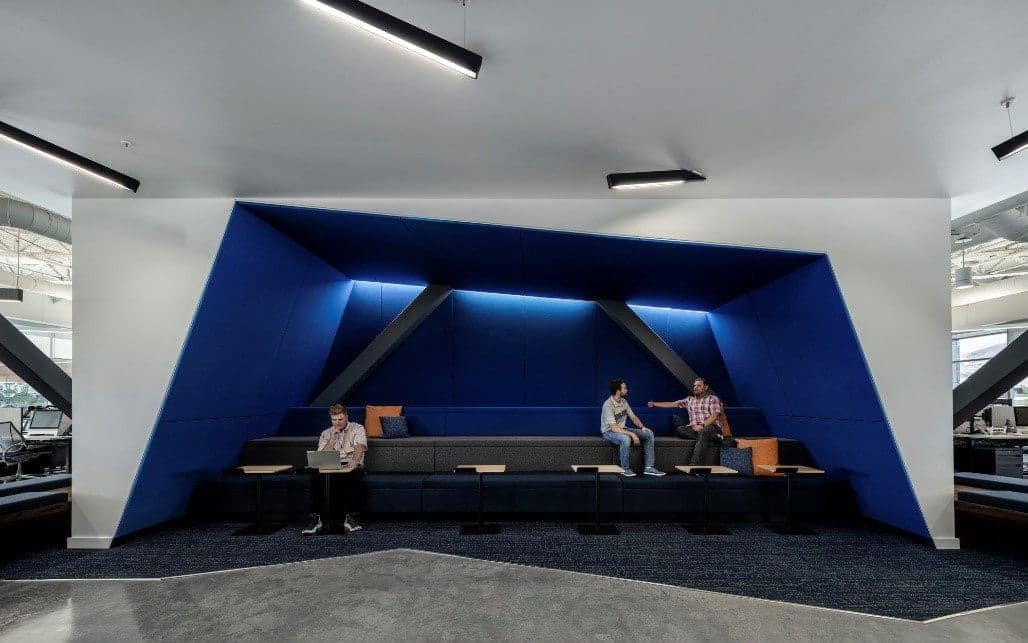
Offering employees a chance to connect with coworkers in the workplace can increase in-office attendance. Confidential Client, Lehi, UT. Photography © James Florio.
The Results
The survey revealed that flexible working was experienced as an informal but routine way of working for some employees. Many employees within the firm did not have what they considered to be a flexible work arrangement. The study points out that in most organizations there is a vague common definition of flexible work, and because of that there are a wide variety of experiences to be had. Employees who did work flexibly understood that it was something provided to them by their company and that it must be self-managed.
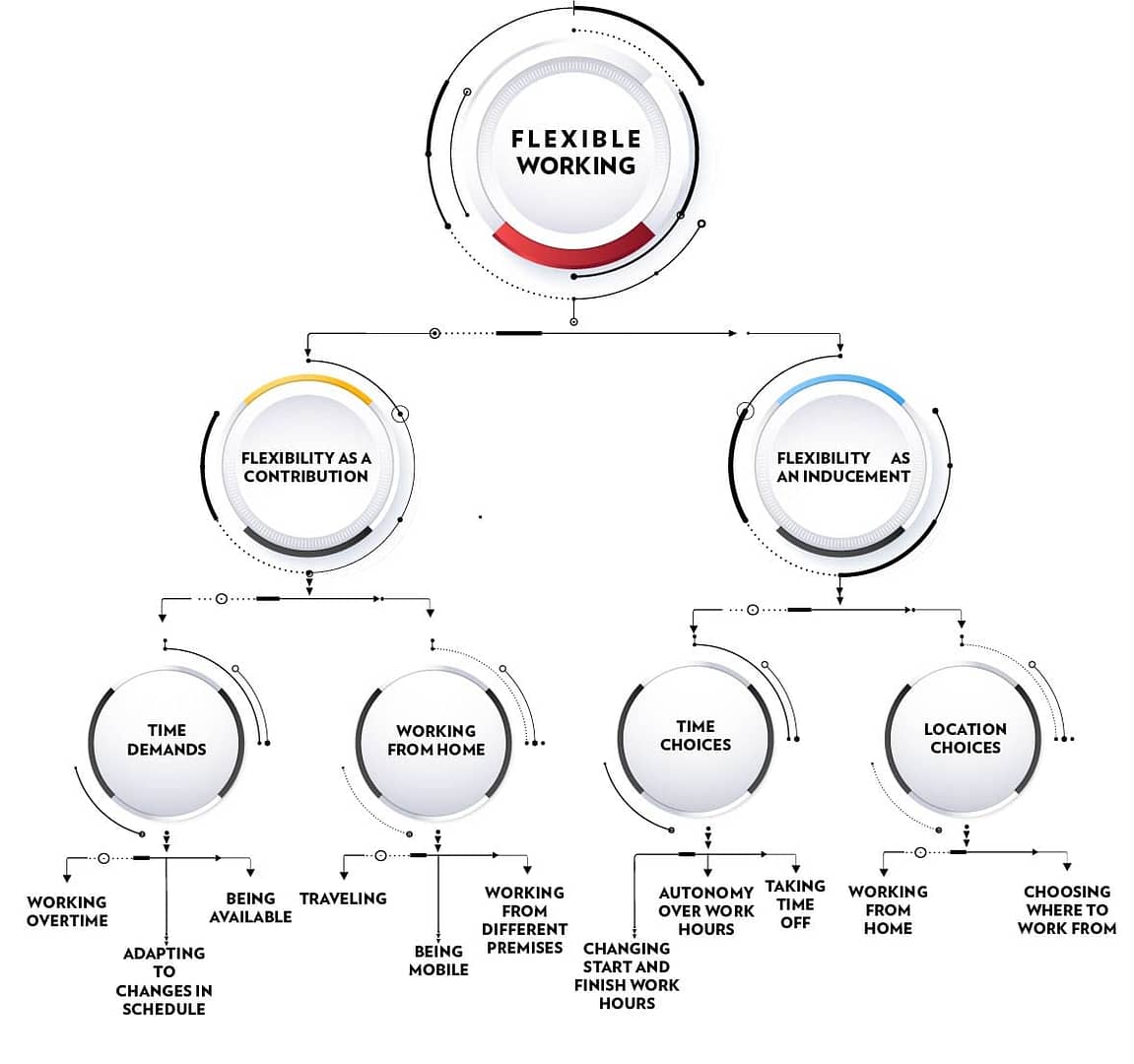
Researchers were able to group employees’ definitions of flexible working into a set of categories where the flexibility was either viewed as a contribution to the employer, or as an inducement for the employee (or both).
The study also found an alternate point of view that defined such an arrangement as a natural response to fluctuating work demands that largely benefited employers. But most employees seemed to experience varying degrees of both of these understandings, and researchers determined that, among other factors, flexibility was viewed as more of an inducement or a contribution depending on things like workload and levels of employee autonomy. There is a perceived push and pull between these two worlds and the pendulum is constantly swinging between them. Ultimately, it is the responsibility of the individual to carve out their own rules and regulations for flexible working while adhering to basic HR policies.
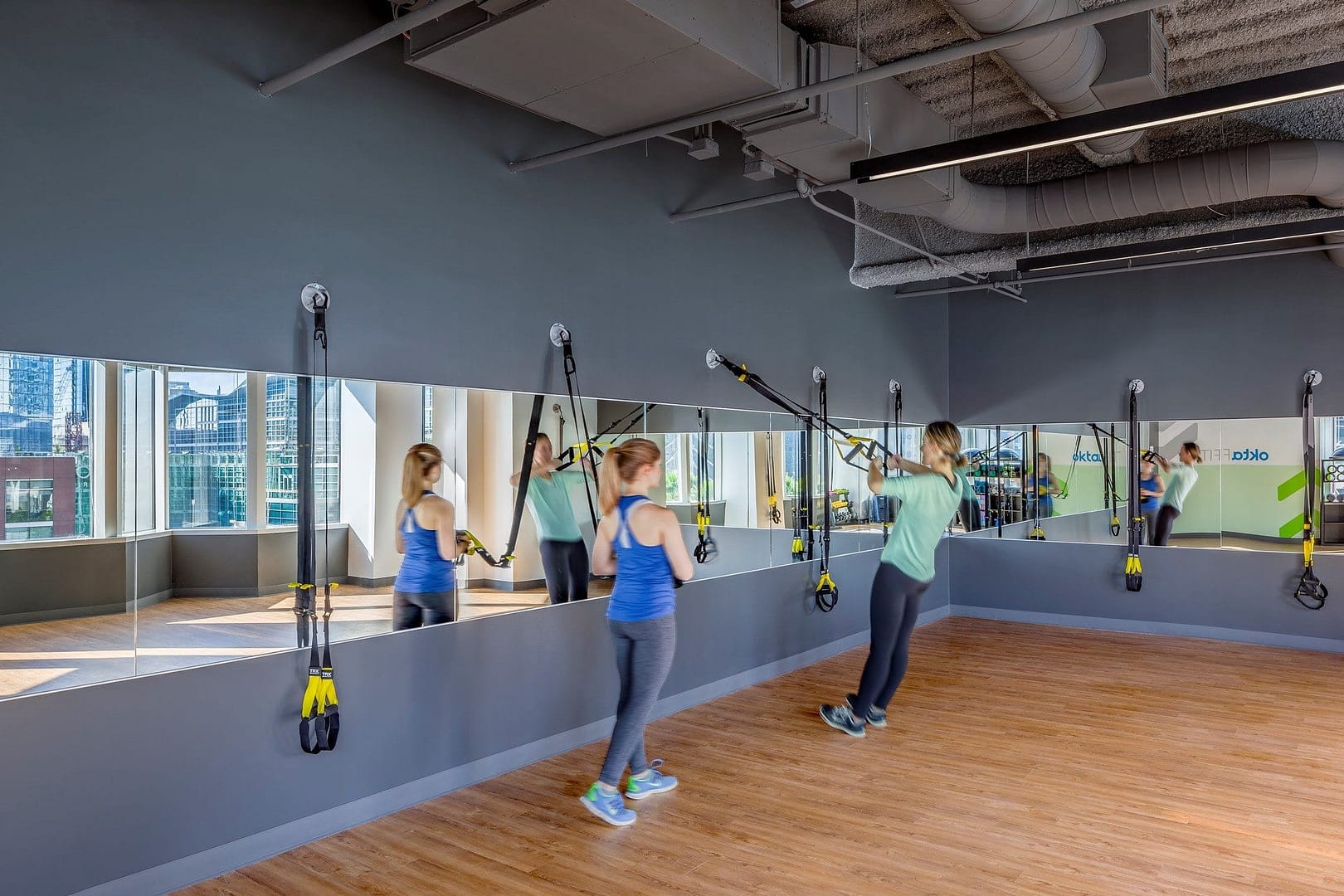
When employees were able to make time for personal wellness, they generally viewed flexible work as an inducement, rather than a contribution to their employer. Okta, San Francisco. Photography © Sherman Takata.
Keys to a Successful Flexible Workplace CONVERSIOn
Recently, IA helped convert the McDonald's headquarters to an almost entirely free address workplace. The effort was a huge success, with post-occupancy surveys reporting a 76% satisfaction rating. We asked a member of the IA team who was a part of this effort, Sarah Bird, LEED AP, what about that project made the conversion so successful?

- A good upfront strategy provided teams with the time and data gathering needed to create a kit of parts that responded to McDonald's' culture/business objectives
- Educating departments during department interviews and programming was key
- All of the changes were supported and championed by leadership
- Change management to explain the different worker types and space types/functions (we didn’t do it – they did)
- Variety was very important. There was a very wide range of work setting types, meeting spaces, focus spaces and areas throughout the entire workspace for employees to choose where and how they want to work (again with leadership encouraging working anywhere)
- Technology (especially relevant apps) allows team members to easily find someone
- Technology is integrated everywhere so it is easy to find power as well as connect to AV
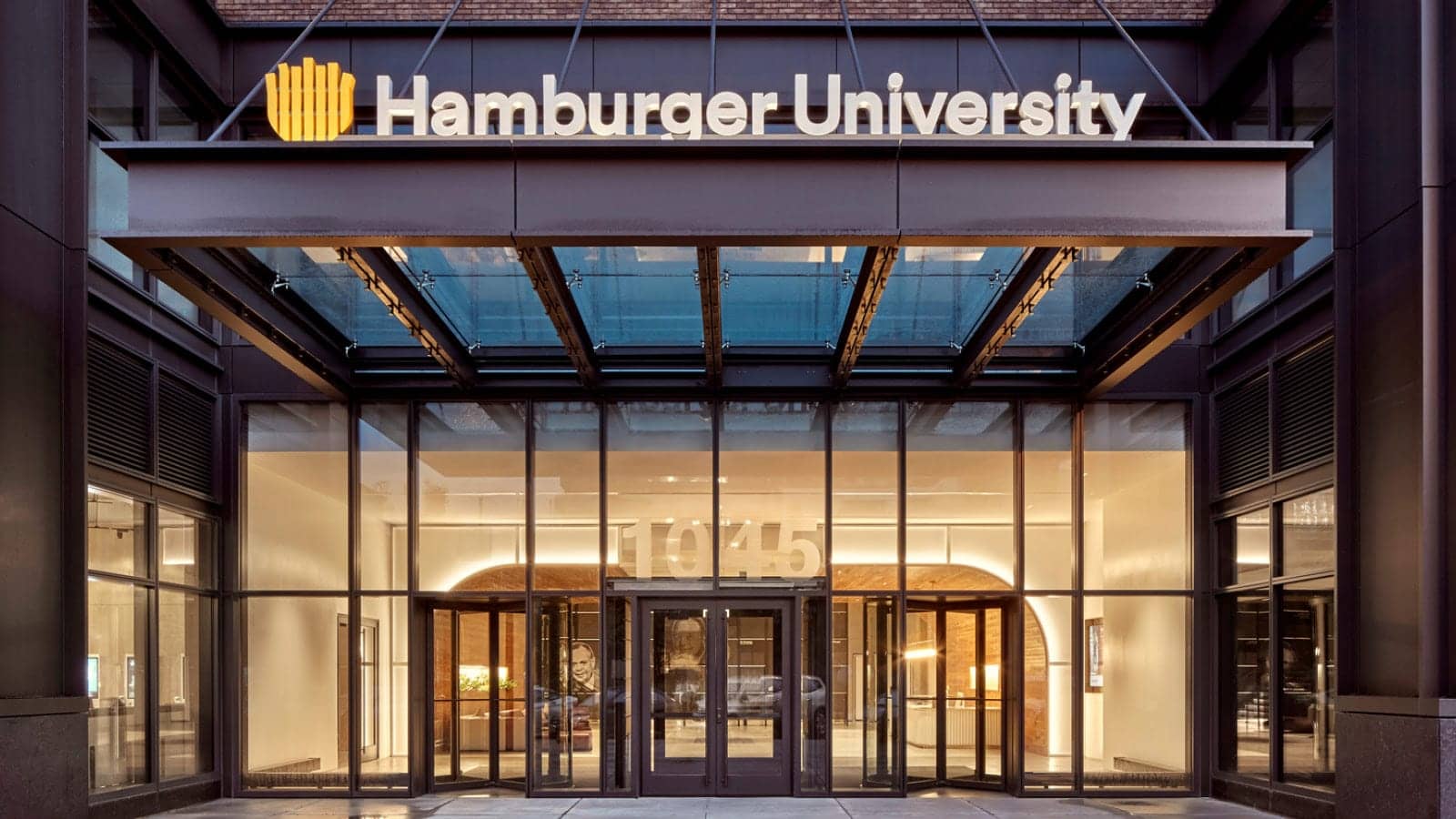
McDonalds Headquarters, Chicago, IL. Photo © Garrett Rowland
How This Affects Us
It’s worth noting that earlier in the research paper it specified that since flexible working was determined casually between managers and employees, many employees did not experience any of the benefits of flexible work. What’s more, since most flexible employees reported viewing the arrangement as primarily benefiting the company or themselves depending on short-term conditions, it became clear to us as workplace designers and architects that there are two primary takeaways from this report:
1. It’s possible to provide traditional (non-flexible) employees with many if not all the positive experiences that flexible working can provide
Employees at Minerva cited “having time to go to the gym twice a week,” “having time for myself,” and being able to go to doctor’s appointments as benefits of a FWA. If considerable thought is put toward providing these benefits inside of the office however, those benefits can be shared by all staff. Creating fitness spaces and wellness areas within the office can help teams find these moments without being a detriment to productivity. Many offices are even taking steps to bring medical facilities or telemedicine on-site in an effort to bring this benefit to all of their employees.
One of the benefits of flexible work identified in the paper is described as the “Choosing Where to Work From” benefit. Creating more alternate work areas and suggesting free-address or unassigned seating can allow employees who rarely leave the office to experience this flexibility and start each day with a potentially new space. Providing work lounges or break areas that can also double as informal collaboration hubs or secondary workplaces allows for the “Starbucks” effect of working as well. Supporting these spaces with phone rooms with dedicated work surfaces drives the point home and can provide teams with much-valued privacy and flexibility.
2. Great design can create a myriad of short-term experiences that can help to improve the employee perception of flexible working
As Minerva employees reflected in the research study, their perception of their work arrangement often varied depending on very temporary conditions, such as workload, travel, or per-project autonomy. As designers and architects the spaces we create can help to manage the variance experienced here and ultimately reduce turnover by creating a wider variety of short-term work experiences. Workplaces should be made to respond to short-term needs, and be customizable to the end-user. In certain cases this should support the use of free-address or unassigned seating, or hoteling stations within the open office that would allow individuals who may work from home regularly to find a place in the office and feel more connected to their team. It's incumbent upon us here at IA to continue pushing the bar to create workplaces that can be physically rearranged at-will, and allow employees to create a greater number of positive short-term experiences, giving them a more satisfied reflection on their flexible work arrangement.
Conclusion:
While flexible work environments are not a one-size-fits-all experience, the study supports the concept that designers can help to manage and improve employee perceptions of the flexible work experience. They can do this by empowering those employees to change how their work and personal schedules interact and allowing them to choose where they do their work. This should be done with the understanding that the space should better permit employees to respond to the location and time demands of their individual role.
The Value of Workplace Flexibility via @IAarchitects - https://interiorarchitects.com/the-value-of-workplace-flexibility/


